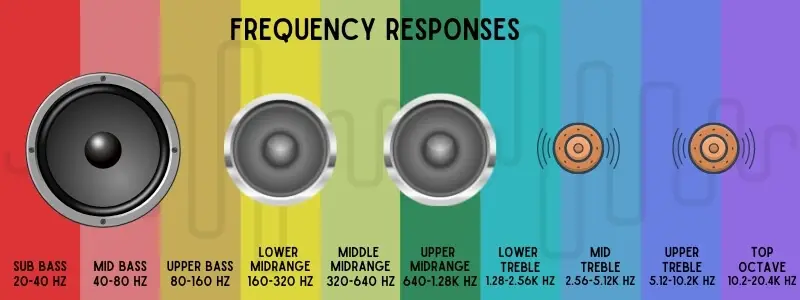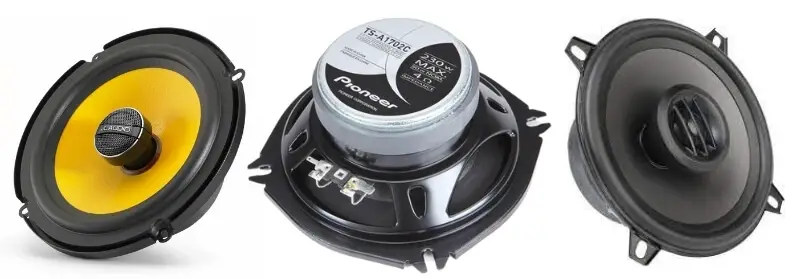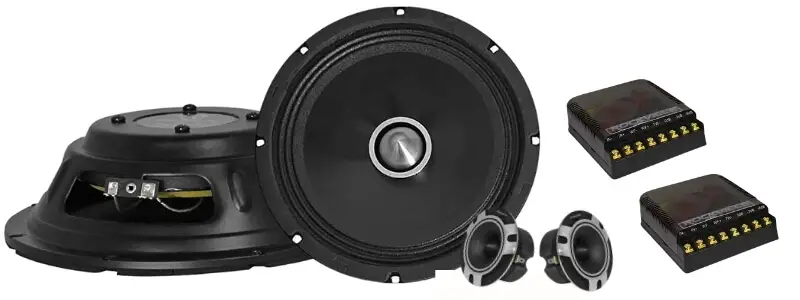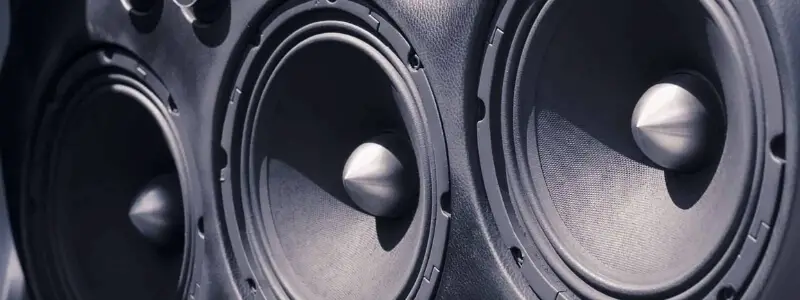Coaxial vs Component Speakers – Which Is Better?
Coaxial vs Component Speakers is one of the most commonly debated topics in the car audio industry. But which speaker type is better?
Choosing the perfect speakers to make sure you get the best listening experience is no straightforward decision, and this topic, like everything else in car audio, has many grey areas.
There are many factors in play, and both speakers drive excellent sounds. That said, component speakers do provide a better and richer sound, but that’s not to say coaxial speakers should be ignored.
Coaxial speakers are the most common speakers for a variety of reasons, and both coaxial and component speakers complement each other in a full car stereo system. So, which are the best car speakers?
When it comes to getting the best set, you have to consider your budget, your experience at fitting them and of course the specifications of the speakers and materials used, because everything plays a part of ensuring you get the best car speakers for you.
>>Looking for some Kicker KS Speakers?<<
What To Look For
There are 2-way, 3-way speakers, and even 4-way speakers, all of which represent the number of different drivers that are part of the speaker. The sounds come out of the different drivers, and a 2-way speaker has two speakers: a woofer and a tweeter.
The 3-way speaker has an additional speaker, which is the mid-range speaker, which allows for better more focused frequencies being driven to each speaker.
4-way speakers aren’t as common, but they have what is known as a super tweeter, which is small driver committed to ultra-high-frequency reproduction.
Each additional driver allows the other to concentrate more on the frequencies they’re designed to produce, and so the clarity and and three dimensional soundscape from speakers with more driver components will sound better.
Understanding Frequencies
Sounds have a ranges of frequencies, from low to high, and each driver is equipped to handle different frequencies. The human ear can handle frequencies between 20Hz and 20,000Hz, and there is no single driver that can handle that range clearly.
The three main types of drivers are woofers for low frequency or bass, which is below 200Hz, the tweeters are for high frequency or treble, which is above 2,000Hz, and the mid-range, which you get in a 3-way speaker is everything in between the low and high frequency.

The frequencies are split by the crossover, which directs the electrical charge to the drivers for them to drive the different sounds. The crossovers are different in standard for the coaxial vs component speakers debate as I will explain in each speaker section.
So without any further ado, let’s take a look at both types of speaker and then afterwards you’ll be able to make a more informed decision on the coaxial vs component speaker debate.
Coaxial Speakers
Coaxial Speakers, also known as full-range speakers, are a speaker with the woofer, tweeter and crossover all connected to the one device, and in the coaxial vs component speaker debate, they’re definitely more popular.
A 2-way coaxial speaker is the most common, and these are made up of the mid-woofer which takes up the whole circumference of the speaker, and the tweeter which protrudes from the middle of the woofer.
The back of the speaker there’s one input terminal which drives the charge to your speakers, and the inbuilt crossover which directs the sounds and sends the mid-range to the woofer and the higher frequencies to the tweeter.
Most coaxial speakers use a low-cost design crossover – a single capacitor connected to the tweeter, but nothing for the woofer because it’s designed to stop producing higher frequencies naturally.
This limits the coaxial speaker’s clarity and overall performance. That said, coaxial speakers drive a good full-range sound quality and frequency coverage, and are a huge upgrade from single-cone speakers that you’ll get with your factory speakers.
You can also get 3-way coaxial speakers, although these aren’t as common as 2-way speakers. Also known as a triaxal speaker, the 3-way coaxial speaker you get a piezo tweeter, which can exceed the frequency limits of tweeters.

It’s important to understand that just because they have an extra speaker, the 3-way coaxial isn’t necessarily better than the 2-way. Sure some are, but with coaxial speakers having a passive crossover, they usually work better when the frequency is split into two, not three.
Because of the design, coaxial speakers are cheaper than component speakers, and they’re also much easier to install, and they also require less power to function correctly.
The main drawback with coaxial speakers, however, is the different ranges can somewhat interfere with each other, especially 3-way speakers. This is more apparent with cheaper brands, and can be annoying if you demand a crystal clear soundscape.
That said, coaxial speakers are a big upgrade from your factory speakers and as long as you get some good quality speakers, you won’t be disappointed.
- Easy upgrade, as they’re a drop-in replacement for older factory speakers.
- An all-in-one full-range sound with no effort.
- The best coaxial speakers are as good as the best 2-way component speakers
- Very Affordable: You can get excellent coaxial speakers for around $50
- Limited sounds, compared with Component Speakers
- Inbuilt corssovers not as effective
Component Speakers
Component Speakers are a bit more technical than coaxial speakers but offer more options with your soundscape.
Instead of all components being together as with the coaxial speaker, the mid-range woofer speaker, the tweeter and the crossover are all separate components. You can buy them all as a speaker set or you can buy them individually, but they are separate components and will be installed in your car separately.
Component speakers often use better dome tweeter and woofer materials, which might include features that you can’t get with coaxial speakers, including a tweeter volume reduction option to help you sculpt the perfect sound for you, and it might also include tweeter fusing, which will protect your speaker against overload.
The crossover on a component speaker set is designed for the specific speaker and is made with better quality capacitors and inductors than what you get on a coaxial speaker.
They use 2 stages of filtering compared with coaxial’s single stage, which ensures bass and midrange sound from the tweeter is filtered more effectively, while the high-range is blocked from the woofer.
This effectiveness at driving different frequencies to their intended component, ensures the sound quality is clearer and the frequency is wider than coaxial speakers.

And for a more surround sound you can place the separate tweeters in a different place from the woofers, or point them in a different direction, giving the listener more control over the soundscape.
The separate components make installing component speakers more complex, but if you are replacing older component speakers, you should be able to fit the tweeters where the old ones were as long as they’re the same size.
If you’re installing component speakers for the first time and you need a new location for the tweeters. The dashboard and A-panels are popular locations because they are slightly away from the car door speakers, and will help you create a realistic three-dimensional soundscape.
Wherever you choose to install the tweeter, it’s a good idea to mount it within 12 inches of the woofer so the different sound frequencies aren’t too far apart.
Some component speakers allow you to mount the tweeter on the woofer, like the way coaxial speakers looks, which makes installing them much easier. And before you think you may as well just get coaxial speakers, don’t forget the crossover on the component speaker will be better and drive better sounds more effectively. It all depends on your specific installation, and the sound you want.
- More advanced system that provides better sound quality.
- Better RMS power handling
- Better crossover component quality
- Can mount tweeters separate from woofers for better imaging and staging
- Usually made of better materials and components
- More complex to install
- They’re more expensive
For a more in-depth look at component speakers, look at my What Are Component Speakers? article.
So, Which Are Better Speakers?
As you’ve already read, there are pros and cons to both, but really the component speaker will drive better, distortion-less loud music at wider and clearer frequencies.
There are some excellent coaxial speakers on the market, but the very best coaxial will not sound as good as the very best component speakers.
Coaxial speakers are designed for a full-range sound from one speaker with the tweeter as part of it, so you have no option for manoeuvring the tweeter for better imaging and staging. And the crossover is limited and made of lesser quality parts.
Whereas, component speakers being separate components are all designed for specific sounds and the quality of the sound is higher. This is thanks to the quality of the crossover, which separates the frequencies more effectively.
This ensures the tweeter won’t have to share the sound with the woofer as is the case with coaxial speakers. Meaning each driver component will only receive the frequencies intended for them, ensuring the details in the music are much clearer.
Component speakers will give you a much richer and clearer sound, they’re a more flexible sound system and the speakers are usually louder than coaxial speakers.

If Component Speakers Are So Much Better, Why Are Coaxial Speakers More Popular?
Component speakers are better, so why is there even a coaxial vs component speakers debate?
Coaxial speakers are more popular than component speakers for a few reasons. Firstly, they do produce an excellent full-range sound, and the upgrade from your car factory speaker is huge.
Coaxial speakers are cheaper and they’re much easier to install. You don’t have to worry about running cables from component to component, drilling holes for your tweeters, or even taking panels off your doors, like you do with components.
With coaxial speakers it’s pretty much a simple out and in replacement, screw tightly and you’re done. This simplicity makes it preferential to someone who just wants a better soundscape.
Coaxial vs Component Speakers
Most audiophiles will go for component speakers, but most people are just happy with an upgrade without spending a small fortune.
Component speakers are better and will give you a much better listening experience, but coaxial speakers are cheaper and easier to install. So, you have to choose which are best car speakers for you.
If you have the money and are confident you can install component speakers, I would recommend them. That said, if you have a full car stereo system and want to run four speakers, a subwoofer or two and a good powerful amplifier, why not put some coaxials in your back doors and component speakers in the front for that that full-range soundscape?
Have you plunged for one or the other? What do you think with the coaxial vs component speaker debate? Please share your experience below with either speaker set…
Looking For Some Car Speakers…
Posts not found

I am a passionate and skilled car audio enthusiast with 15 years of experience in the industry. My journey started when I replaced my first set of factory car speakers, sparking a deep love for high-quality sound. Since then, I have worked as a representative for renowned brands like Kenwood and Alpine.
With a background in both retail and distribution, I have developed a comprehensive understanding of the car audio market. Currently a certified (MECP) installer in the Mobile Electronics industry, my expertise lies in delivering top-notch audio installations. My knowledge, coupled with my genuine passion, makes me the go-to professional for all car audio needs.


I want to install some new door speakers and rear deck speakers, but not sure which is best either coaxial or component speakers. I’m not exactly an audiophile, but I do want good quality sound. I might get a subwoofer further down the line.
It’s really up to you. If you’re not sure, and you haven’t installed any before, you might be better getting some good quality coaxials. But as the article says, you will get a better sounds with components.